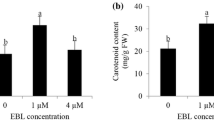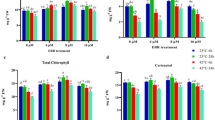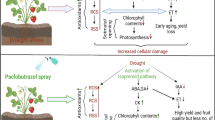Abstract
Low temperature constitutes one of the major threats in horticulture and is adversely affecting fruit production worldwide. Plant hormones, including 24-Epibrassinolide (EBL), may mitigate the malignant effects of cold stress on plants. We investigated the influences of EBL application on protein and proline content, lipid peroxidation and organic and phenolic acids of strawberry plant under cold stress. Two days before the chilling stress, three different EBL doses (1, 2 and 4 mM) were treated once (in August) to plant rhizoplane (above plant parts of soil) as solution except control. To perform chilling treatment, the plants were transferred to a cold storage from the greenhouse. Storage temperature decreased from 15 °C to 7 °C step by step and plants were hold 24 h at 7 °C. End of the study, 4 mM EBL decreased protein content in leaf and root, while it increased in stem. Among tissues of strawberry plant, higher accumulation of malondialdehyde (MDA) was observed in leaves, therefore it can be accepted that leaves are more vulnerable than stems and roots. Different EBL doses enhanced phenolic acids compared to control. The predominant phenolic acid was chlorogenic acid. EBL application increased organic acids except oxalic and malic acids compared to control. The main organic acid found in strawberry leaves exposed to cold stress in the current experiment was malic acid followed by citric and tartaric acids. Our results demonstrated that EBL alleviated the deleterious effects of cold stress in strawberry plant may be due to organic and phenolic acids and maintaining cell membrane integrity.
Similar content being viewed by others
References
Aras S, Eşitken A (2013) Effects of antifreeze proteins and glycine betaine on strawberry plants for resistance to cold temperature. In: Proceedings of International Conference on Agriculture and Biotechnology Malaysia, pp 29–30
Aras S, Arıkan Ş, İpek M, Eşitken A, Pırlak L, Dönmez MF, Turan M (2018) Plant growth promoting rhizobacteria enhanced leaf organic acids, FC‑R activity and Fe nutrition of apple under lime soil conditions. Acta Physiol Plant 40(6):120
Arora A, Byrem TM, Nair MG, Strasburg GM (2000) Modulation of liposomal membrane fluidity by flavonoids and isoflavonoids. Arch Biochem Biophys 373(1):102–109
Bajguz A, Hayat S (2009) Effects of brassinosteroids on the plant responses to environmental stresses. Plant Physiol Biochem 47(1):1–8
Bates LS, Waldren RP, Teare ID (1973) Rapid determination of free proline for water-stress studies. Plant Soil 39:205–207
Bhandari MR, Kawabata J (2004) Organic acid, phenolic content and antioxidant activity of wild yam (Dioscorea spp.) tubers of Nepal. Food Chem 88(2):163–168
Blokhina O, Virolainen E, Fagerstedt KV (2003) Antioxidants, oxidative damage and oxygen deprivation stress: a review. Ann Bot 91(2):179–194
Bradford MM (1976) A rapid and sensitive method for the quantitation of microgram quantities of protein utilizing the principle of protein-dye binding. Anal Biochem 72:248–254
Cao YY, Yang MT, Li X, Zhou ZQ, Wang XJ, Bai JG (2014) Exogenous sucrose increases chilling tolerance in cucumber seedlings by modulating antioxidant enzyme activity and regulating proline and soluble sugar contents. Sci Hortic 179:67–77
Clouse SD, Sasse JM (1998) Brassinosteroids: essential regulators of plant growth and development. Annu Rev Plant Physiol Plant Mol Biol 49:427–451
Das P, Manna I, Sil P, Bandyopadhyay M, Biswas AK (2019) Exogenous silicon alters organic acid production and enzymatic activity of TCA cycle in two NaCl stressed indica rice cultivars. Plant Physiol Biochem 136:76–91
Fariduddin Q, Yusuf M, Chalkoo S, Hayat S, Ahmad A (2011) 28-homobrassinolide improves growth and photosynthesis in Cucumis sativus L. through an enhanced antioxidant system in the presence of chilling stress. Photosynthetica 49(1):55–64
Gao H, Zhang Z, Lv X, Cheng N, Peng B, Cao W (2016) Effect of 24-epibrassinolide on chilling injury of peach fruit in relation to phenolic and proline metabolisms. Postharvest Biol Technol 111:390–397
Ghasemzadeh A, Ghasemzadeh N (2011) Flavonoids and phenolic acids: Role and biochemical activity in plants and human. J Med Plants Res 5(31):6697–6703
Hare PD, Cress WA (1997) Metabolic implications of stress-induced proline accumulation in plants. Plant Growth Regul 21(2):79–102
Hare PD, Cress WA, Van Staden J (1999) Water stress induced changes in concentrations of proline and total soluble sugars in nodulated alfalfa (Medicago sativa) plants. Physiol Plant 84:55–60
Jiang W, Bai J, Yang X, Yu H, Liu Y (2012) Exogenous application of abscisic acid, putrescine, or 2, 4‑epibrassinolide at appropriate concentrations effectively alleviate damage to tomato seedlings from suboptimal temperature stress. HortTechnology 22(1):137–144
Jiang YP, Huang LF, Cheng F, Zhou YH, Xia XJ, Mao WH, Shi K, Yu JQ (2013) Brassinosteroids accelerate recovery of photosynthetic apparatus from cold stress by balancing the electron partitioning, carboxylation and redox homeostasis in cucumber. Physiol Plant 148(1):133–145
Jiménez S, Ollat N, Deborde C, Maucourt M, Rellán-Álvarez R, Moreno MÁ, Gogorcena Y (2011) Metabolic response in roots of Prunus rootstocks submitted to iron chlorosis. J Plant Physiol 168(5):415–423
Jones DL (1998) Organic acids in the rhizosphere—a critical review. Plant Soil 205(1):25–44
Kim D, Jeond S, Lee C (2003) Antioxidant capacity of phenolic phytochemicals from various cultivars of plums. Food Chem 81:321–326
Li B, Zhang C, Cao B, Qin G, Wang W, Tian S (2012) Brassinolide enhances cold stress tolerance of fruit by regulating plasma membrane proteins and lipids. Amino Acids 43(6):2469–2480
Liu P, Yang B, Kallio H (2010) Characterization of phenolic compounds in Chinese hawthorn (Crataegus pinnatifida Bge. var. major) fruit by high performance liquid chromatography–electrospray ionization mass spectrometry. Food Chem 121(4):1188–1197
Liu ZJ, Zhang XL, Bai JG, Suo BX, Xu PL, Wang L (2009) Exogenous paraquat changes antioxidant enzyme activities and lipid peroxidation in drought stressed cucumber leaves. Sci Hortic 121:138–143
Lopez-Bucio J, Nieto-Jacobo MF, Ramırez-Rodriguez V, Herrera-Estrella L (2000) Organic acid metabolism in plants: from adaptive physiology to transgenic varieties for cultivation in extreme soils. Plant Sci 160(1):1–13
Madhava RKV, Sresty TVS (2000) Antioxidative parameters in the seedlings of pigeonpea (Cajanus cajan L. Millspaugh) in response to Zn and Ni stress. Plant Sci 157:113–128
Marino G, Beghelli S, Rombolà AD, Cabrini L (2000) In vitro performance at high culture pH and in vivo responses to Fe-deficiency of leaf-derived quince BA 29 (Cydonia oblonga) somaclones regenerated at variable medium pH. J Hortic Sci Biotechnol 75(4):433–440
Michalak A (2006) Phenolic compounds and their antioxidant activity in plants growing under heavy metal stress. Pol J Environ Stud 15(4):523–530
Milić BL, Djilas SM, Čanadanović-Brunet JM (1998) Antioxidative activity of phenolic compounds on the metal-ion breakdown of lipid peroxidation system. Food Chem 61(4):443–447
Öztürk N, Tunçel M (2011) Assessment of phenolic acid content and in vitro antiradical characteristics of hawthorn. J Med Food 14(6):664–669
Pennycooke JC, Cox S, Stushnoff C (2005) Relationship of cold acclimation, total phenolic content and antioxidant capacity with chilling tolerance in petunia (Petunia× hybrida). Environ Exp Bot 53(2):225–232
Prasad TK, Anderson MD, Martin BA, Stewart CR (1994) Evidence for chilling-induced oxidative stress in maize seedlings and a regulatory role for hydrogen peroxide. Plant Cell 6:65–74
Qu T, Liu R, Wang W, An L, Chen T, Liu G, Zhao Z (2011) Brassinosteroids regulate pectin methylesterase activity and AtPME41 expression in Arabidopsis under chilling stress. Cryobiology 63(2):111–117
Rice-Evans C, Miller N, Paganga G (1997) Antioxidant properties of phenolic compounds. Trends Plant Sci 2(4):152–159
Rivero RM, Ruiz JM, Garcia PC, Lopez-Lefebre LR, Sánchez E, Romero L (2001) Resistance to cold and heat stress: accumulation of phenolic compounds in tomato and watermelon plants. Plant Sci 160(2):315–321
Sasse JM (2003) Physiological actions of brassinosteroids: an update. J Plant Growth Regul 22:276–288
Serna M, Hernández F, Coll F, Coll Y, Amorós A (2013) Effects of brassinosteroid analogues on total phenols, antioxidant activity, sugars, organic acids and yield of field grown endive (Cichorium endivia L.). J Sci Food Agric 93(7):1765–1771
Singleton VL, Rossi JR (1965) Colorimetry of total phenolics with phosphomolybdic-phosphotungstic acid. Am J Enol Vitic 16:144–158
Taiz L, Zeiger E (1998) Stress physiology. In: Bressan RA, Locy RB (eds) Plant physiology. Sinauer Associates Press, Sunderland, pp 591–614
Wu XX, Ding HD, Chen JL, Zhu ZW, Zha DS (2015) Amelioration of oxidative damage in Solanum melongena seedlings by 24-epibrassinolide during chilling stress and recovery. Biol Plantarum 59(2):350–356
Wu XX, He J, Zhu ZW, Yang SJ, Zha DS (2014) Protection of photosynthesis and antioxidative system by 24-epibrassinolide in Solanum melongena under cold stress. Biol Plantarum 58(1):185–188
Xi Z, Wang Z, Fang Y, Hu Z, Hu Y, Deng M, Zhang Z (2013) Effects of 24-epibrassinolide on antioxidation defense and osmoregulation systems of young grapevines (V. vinifera L.) under chilling stress. Plant Growth Regul 71(1):57–65
Yong Z, Hao-Ru T, Ya L (2008) Variation in antioxidant enzyme activities of two strawberry cultivars with short-term low temperature stress. World J Agric Sci 4(4):458–462
Zhou YL, Huo SF, Wang LT, Meng JF, Zhang ZW, Xi ZM (2018) Exogenous 24-Epibrassinolide alleviates oxidative damage from copper stress in grape (Vitis vinifera L.) cuttings. Plant Physiol Biochem 130:555–565
Author information
Authors and Affiliations
Corresponding author
Ethics declarations
Conflict of interest
G. Balcı, S. Aras and H. Keles declare that they have no competing interests.
Rights and permissions
About this article
Cite this article
Balcı, G., Aras, S. & Keles, H. Exogenous EBL (24-Epibrassinolide) Alleviate Cold Damage in Strawberry. Erwerbs-Obstbau 63, 273–278 (2021). https://doi.org/10.1007/s10341-021-00566-6
Received:
Accepted:
Published:
Issue Date:
DOI: https://doi.org/10.1007/s10341-021-00566-6




